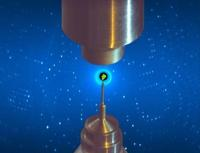Speaker
Description
Fluorescent proteins (FPs) have revolutionized the imaging technologies in biological science. A better understanding of the structure and function for FPs will help to develop new molecular designs to generate further practical devices. Recently, we reported neutron structural analysis of the green fluorescent protein (GFP) to show the characteristic protonation (deuteration) states of the chromophore and surrounding key residues with their hydrogen-bonding network, including water molecules, by neutron crystallography. The structure has a deprotonated hydroxyl group in the fluorescent chromophore. Also, the protonation states of His148 and Thr203, as well as the orientation of a critical water molecule in direct contact with the chromophore, could be determined. The results demonstrate that the deprotonated hydroxyl group in the chromophore and the nitrogen atom ND1 in His148 are charged negatively and positively, respectively, forming an ion pair. The position of the two deuterium atoms in the critical water molecule appears to be displaced slightly toward the acceptor oxygen atoms according to the obtained omit maps. This displacement implies the formation of an intriguing electrostatic potential realized inside the protein. Our findings provide new insights into future protein design strategies along with developments in quantum chemical calculations.

